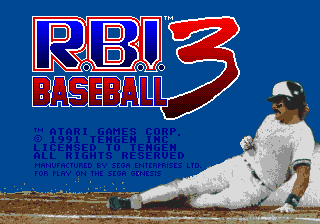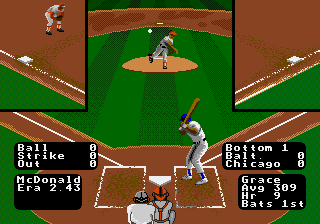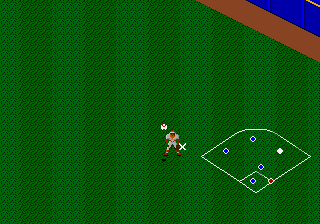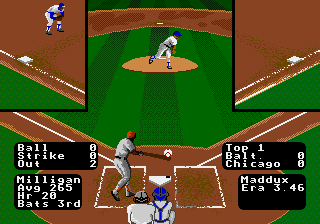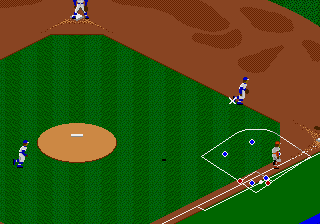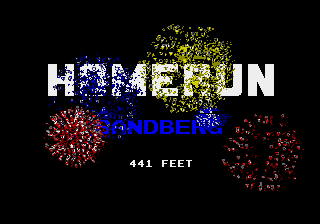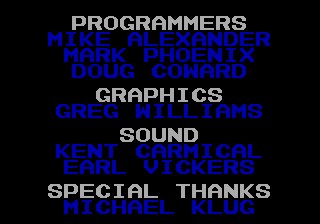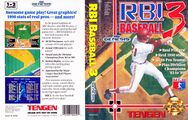R.B.I. Baseball 3
From Sega Retro
| R.B.I. Baseball 3 | ||||||||||
|---|---|---|---|---|---|---|---|---|---|---|
| System(s): Sega Mega Drive | ||||||||||
| Publisher: Tengen | ||||||||||
| Developer: Tengen | ||||||||||
| Licensor: Atari Games, Major League Baseball Players Association | ||||||||||
| Sound driver: Lisa's Sound Driver[1] | ||||||||||
| Genre: Sports (baseball) | ||||||||||
| Number of players: 1-2 (alternating) | ||||||||||
|
R.B.I. Baseball 3, also known as RBI Baseball 3, R.B.I. 3 Baseball, or RBI 3 Baseball is a baseball game released for the Sega Mega Drive. It is the direct sequel to R.B.I. Baseball 2 (which was not released on a Sega system) and was only released in North America. "R.B.I." is short for "runs batted in," a statistic used for batters in baseball.
R.B.I. Baseball 3 was followed by R.B.I. Baseball 4, a Mega Drive exclusive. Following this, R.B.I. Baseball '93 and R.B.I. Baseball '94 were released for the console, with RBI Baseball '95 being a Sega 32X exclusive.
Contents
Gameplay
The game is a Major League Baseball game including the 26 teams of the 1990 MLB season. The game carries a Major League Baseball Players Association license, so it contains all of the Major League Baseball players but not the team names or logos. The game uses a high view from behind the umpire for pitching and hitting, then switches to an overhead view for fielding and running. There is only one stadium.
Modes
The game has the following modes:
- 1P Play: Starts a game between a human player and a computer player. It is a best-of-seven series if the player chooses one team from the American League and one team from the National League or if the player chooses a division winner for the computer team. Or the player can play against every team in the 1990 league by selecting a 1990 team to play and selecting another team from the same league for the computer or by selecting a division winner to play and selecting a 1990 team from the same league for the computer (finishing with a game against a special all-star team if the player succeeds). Otherwise, the game will be an exhibition game. Series games use a password system for continuing.
- 2P Play: Starts a game between two human players. It is a best-of-seven series regardless of which teams are chosen.
- Watch: Starts a game between two computer players. Both players can override a computer player by using their respective control pad during play.
Games are always nine innings. Players can choose any two teams from either league (which can be the same team in an exhibition game). The player chooses the teams of computer players. Player one is always the visiting team and bats first. After choosing a team, players choose the starting pitchers and set the batting line-up. A pitcher can only start every other game in a series.
In the options, players can choose from three difficulty levels for computer-controlled opponents (Easy, Medium, and Hard).
Teams
Current
The game includes all 26 teams from the 1990 MLB season.
| League | Division | Team | Based on |
|---|---|---|---|
| American | West | California | California Angels |
| Chicago | Chicago White Sox | ||
| Kansas City | Kansas City Royals | ||
| Minnesota | Minnesota Twins | ||
| Oakland | Oakland Athletics | ||
| Seattle | Seattle Mariners | ||
| Texas | Texas Rangers | ||
| East | Baltimore | Baltimore Orioles | |
| Boston | Boston Red Sox | ||
| Cleveland | Cleveland Indians | ||
| Detroit | Detroit Tigers | ||
| Milwaukee | Milwaukee Brewers | ||
| New York | New York Yankees | ||
| Toronto | Toronto Blue Jays | ||
| National | West | Atlanta | Atlanta Braves |
| Cincinnati | Cincinnati Reds | ||
| Houston | Houston Astros | ||
| Los Angeles | Los Angeles Dodgers | ||
| San Diego | San Diego Padres | ||
| San Francisco | San Francisco Giants | ||
| East | Chicago | Chicago Cubs | |
| Montreal | Montreal Expos | ||
| New York | New York Mets | ||
| Philadelphia | Philadelphia Phillies | ||
| Pittsburgh | Pittsburgh Pirates | ||
| St. Louis | St. Louis Cardinals |
Previous
In addition, the game includes historical rosters of every division-winning team going back to 1983.
| League | Year | West | East | ||
|---|---|---|---|---|---|
| Team | Based on | Team | Based on | ||
| American | 1989 | Oakland | Oakland Athletics | Toronto | Toronto Blue Jays |
| 1988 | Oakland | Oakland Athletics | Boston | Boston Red Sox | |
| 1987 | Minnesota | Minnesota Twins | Detroit | Detroit Tigers | |
| 1986 | California | California Angels | Boston | Boston Red Sox | |
| 1985 | Kansas City | Kansas City Royals | Toronto | Toronto Blue Jays | |
| 1984 | Kansas City | Kansas City Royals | Detroit | Detroit Tigers | |
| 1983 | Chicago | Chicago White Sox | Baltimore | Baltimore Orioles | |
| National | 1989 | San Francisco | San Francisco Giants | Chicago | Chicago Cubs |
| 1988 | Los Angeles | Los Angeles Dodgers | New York | New York Mets | |
| 1987 | San Francisco | San Francisco Giants | St. Louis | St. Louis Cardinals | |
| 1986 | Houston | Houston Astros | New York | New York Mets | |
| 1985 | Los Angeles | Los Angeles Dodgers | St. Louis | St. Louis Cardinals | |
| 1984 | San Diego | San Diego Padres | Chicago | Chicago Cubs | |
| 1983 | Los Angeles | Los Angeles Dodgers | Philadelphia | Philadelphia Phillies | |
All-Star
Finally, the game includes the 1990 All-Star teams for each league.
Production credits
- Programmers: Michael Alexander, Mark Phoenix, Doug Coward
- Graphics: Greg Williams
- Sound: Kent Carmical, Earl Vickers
- Special Thanks: Michael Klug
Magazine articles
- Main article: R.B.I. Baseball 3/Magazine articles.
Promotional material
also published in:
- Electronic Gaming Monthly (US) #30: "January 1992" (199x-xx-xx)[5]
also published in:
- GamePro (US) #31: "February 1992" (199x-xx-xx)[7]
- Electronic Gaming Monthly (US) #32: "March 1992" (1992-xx-xx)[8]
Physical scans
| Sega Retro Average | ||||||||||||||||||||||||
|---|---|---|---|---|---|---|---|---|---|---|---|---|---|---|---|---|---|---|---|---|---|---|---|---|
|
| 62 | |
|---|---|
| Based on 4 reviews | |
Technical information
- Main article: R.B.I. Baseball 3/Technical information.
References
- ↑ http://vgmpf.com/Wiki/index.php?title=LSD_(GEN_Driver)
- ↑ GamePro, "June 1991" (US; 1991-xx-xx), page 42
- ↑ 3.0 3.1 GamePro, "January 1992" (US; 199x-xx-xx), page 79
- ↑ File:R.B.I. Baseball 3 MD credits.png
- ↑ Electronic Gaming Monthly, "January 1992" (US; 199x-xx-xx), page 24
- ↑ GamePro, "16-bit Video Gaming: February 1992" (US; 1992-xx-xx), page 46
- ↑ GamePro, "February 1992" (US; 199x-xx-xx), page 59
- ↑ Electronic Gaming Monthly, "March 1992" (US; 1992-xx-xx), page 141
- ↑ 1700 igr dlya Sega, "" (RU; 2001-xx-xx), page 185
- ↑ Sega Pro, "April 1993" (UK; 1993-03-11), page 67
- ↑ Tricks 16 bit, "Tricks Sega Gold 800 igr" (RU; 1998-03-20), page 207
| R.B.I. Baseball 3 | |
|---|---|
|
Main page | Hidden content | Magazine articles | Reception | Region coding | Technical information
Prototypes: 1991-07-18
| |
| R.B.I. Baseball games for Sega systems | |
|---|---|
| R.B.I. Baseball 3 (1991) | R.B.I. Baseball 4 (1992) | R.B.I. Baseball '93 (1993) | R.B.I. Baseball '94 (1994) | R.B.I. Baseball '95 (unreleased) | RBI Baseball '95 (1995) | |
